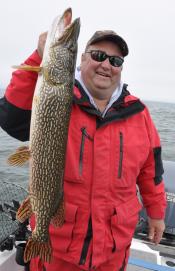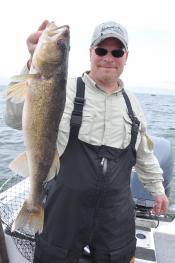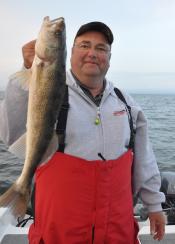 Open water trolling for walleyes can be very productive as long as you have the proper trolling equipment to get the job done on a consistent basis.
Open water trolling for walleyes can be very productive as long as you have the proper trolling equipment to get the job done on a consistent basis.
On Saturday I conducted an Open Water / On the Water Trolling Clinic and had the pleasure of meeting Dave Wengeler, Paul Schneider and Dale Luoma. All of these guys are hardcore walleye anglers and spend many days on Mille Lacs lindy rigging, spinner rigging and corking for fish. Each of them wanted to learn more about the keys to success for open water trolling so they could go back in their boat and be successful.
The weather had been unstable the two days prior, which had the lake stirred up. In the morning, we couldn’t even tell which way the wind was blowing because the waves were coming from all directions. I’ve fished in these types of conditions before and it’s difficult because the zooplankton and baitfish do not ball up and the tullibees end up scattered all over the water column.
We battled the elements still managed to have a productive day. Most of the walleyes that we caught were tight to the bottom, which probably meant they were feeding more on perch than on tullibees. Deep Tail Dancers #11’s pulled on braided line with a planer board was best as we placed those crankbaits 4-6 feet off the bottom in 32-35 feet of water. Paul also caught a bonus 36 inch pike! That was the first fish of the day and the guys got a chuckle out of that considering they signed up for an open water trolling walleye clinic!
 After the day ended, a couple of buddies of mine (Matt Schultz and Craig Dougherty) hopped in my boat and we decided to troll some crankbaits at night in the shallows. Trolling conditions were not ideal as we tried fishing in 2-3 footers in a dense fog. It was so thick that my GPS would lose the signal once in awhile. We targeted steep break lines that had some early vegetation growth in 13-15 feet of water. Even though it was difficult to maintain boat control, we really got into them and ended up catching 39 more walleyes before we were chased off by thunderstorms.
After the day ended, a couple of buddies of mine (Matt Schultz and Craig Dougherty) hopped in my boat and we decided to troll some crankbaits at night in the shallows. Trolling conditions were not ideal as we tried fishing in 2-3 footers in a dense fog. It was so thick that my GPS would lose the signal once in awhile. We targeted steep break lines that had some early vegetation growth in 13-15 feet of water. Even though it was difficult to maintain boat control, we really got into them and ended up catching 39 more walleyes before we were chased off by thunderstorms.
17 hours straight on the water made it a great day! Thank you Dave, Paul and Dale for a very memorable time on the water. What I love most about conducting these clinics is that I get to meet so many passionate anglers like myself! The day after it was also great receiving some text messages from Dave as he implemented what he learned during the open water trolling clinic and ended catching a bunch of walleyes on his own!
Fishing with Matt and Craig was also full of laughs and fun! My gut still hurts from laughing when Craig “the net man” didn’t do his job and we (I mean he) lost the biggest fish of the night on a botched net job. Yes – it was my fish too! He calmly said, “too bad we can’t count that one because you didn’t get it in the boat”. I still think it was an over, but he reminded me that we have to measure it first.
 Recently I was asked about what makes up a good open water trolling rod and a line counter reel. I thought I would share my thoughts here as well.
Recently I was asked about what makes up a good open water trolling rod and a line counter reel. I thought I would share my thoughts here as well.
Planer Board Trolling Rod: I prefer a 9’ to 10’6’ trolling rod. The longer length allows you to place your planer board further away from your boat. In windy conditions when you’re experiencing 2-3 footers, you don’t want your line between your planer board and your rod tip to touch the water. When this happens, it will surge your planer board forward and create a pull/pause affect. Your crankbait below will end up doing the same thing and it will not run smoothly.
Longer is not always better… I do not care for a 12’ or a 14’ trolling rod when fishing with planer boards. Even though my boat is 21 feet long, I still find them very difficult to work with when attaching/detaching a planer board. When fishing with planer boards, it crucial to quickly detach it in order to maintain pressure on the fish. This is where it is most likely to lose a
The planer board trolling rod should have a very soft tip. This will help absorb the shock of the waves and keep your crankbait running smoothly below.
Look for a medium to heavy medium action rod with a stiffer bank and a moderate/heavy full flex. This will help absorb the weight of your planer board and a big walleye at the same time while trolling at 2 mph.
The handle should be long (12-14 inches) which will allow you to gain some leverage if needed. I like to place the long handle against my rib cage helping me stabilize the trolling rod. My favorite trolling rods are St Croix Eyecons and St. Croix Wild Rivers. However, there are many other good ones to choose from for a reasonable price.
 Lead Core Trolling Rod: If I’m long lining a lead core line out the back of the boat, I prefer an 8-9’ trolling rod. I like a soft rounded tip as well. When you troll with lead core, there will be a bow in your line. The soft rounded tip will act as a cushion as your boat surges in the waves, which will allow your crankbait to run more consistent and help with depth control. The bank should be heavier than your planer board rod which will help carry the weight of the leadcore. Handles in the 10-12 inch range will help you stabilize the rod.
Lead Core Trolling Rod: If I’m long lining a lead core line out the back of the boat, I prefer an 8-9’ trolling rod. I like a soft rounded tip as well. When you troll with lead core, there will be a bow in your line. The soft rounded tip will act as a cushion as your boat surges in the waves, which will allow your crankbait to run more consistent and help with depth control. The bank should be heavier than your planer board rod which will help carry the weight of the leadcore. Handles in the 10-12 inch range will help you stabilize the rod.
The longer lead core trolling rods also help me keep the lines away from the boat. This is important when you’re reeling a fish on another line and it will help you avoid tangles.
Line Counter Reels: Having a line counter reel is a must when you are open water trolling. There are many to choose from and you basically get what you pay for. One of the best out there is made by Shimano and it’s called aTekota. They make them in many sizes, 300LC, 500LC, 600LC, 700LC and 800LC. The 300LC works well when using braid/mono with a planer board or when you’re using Sufix 832 lead core. I would move up to the 500LC or the 600LC if you plan on using regular lead core. The larger 700LC and 800LC are mainly used for bigger species than walleye. These reels are really smooth including the drag. You can also tighten the drag one click at a time so you don’t over compensate . I also like the big oversized handle. It helps when you are reeling in a bigger fish along with a planer board.
Another good line counter reel for the money is the Diawa 27LC and 47LC. I used these for years before I started buying the Shimano Tekotas. They’re not as smooth as the Tekotas but it’s a good reel for the money. Regardless of what line counter reel you choose, be sure to put on some cheap mono backing (I use 20 lb test) to help fill up your spool. This will save money on your more expensive braided line.
It’s also critical to make sure your line counter reels are reading accurately. Most anglers think your line counter reel reads feet – it does not. It actually measures revolutions of your spool. If your spool is close to being full – it will most likely read accurately (12 inches pre revolution). The problem comes when your spool is half full or less. It will most likely read 13-16 inches or even more. That’s 10-30% off! The way to check it is to go out in your yard and measure 150 feet with a tape measure. Then pull your line off your line counter reel and check. Adjust accordingly if needed by adding or taking off more line. Or calculate how much you’re off and adjust on the water. For example, if your line counter reads 180 instead of 150, it’s 20% off so you need to add 20% when you’re on the water to achieve your desired depth.
If you’re interested in trying out a open water trolling rod and/or reel – contact Dean Marshall at Anglers Guide HQ . He will take care of you and ship it directly to your door. I buy all my equipment from him and he stands behind his product.
The open water trolling bite is a good 2-3 weeks behind compared to a normal year. Hopefully these warmer air temps this week will push the water temps up which will help congregate the tullibees in deeper water. Now’s the time to get out there and try it! As always, I’m here to help so feel free to reach out to me with any questions.
Until next time, keep trollin’!
Nice report Brad, I have a little slush fund saved up Id like to get 4 of the eyecons and 4 Tekotas, James had some with last summer out here and they are a sweet setup. About how many feet of braided line are you putting on your rod over your backing and about how much mono are you putting on say a 300 series takota, – QB